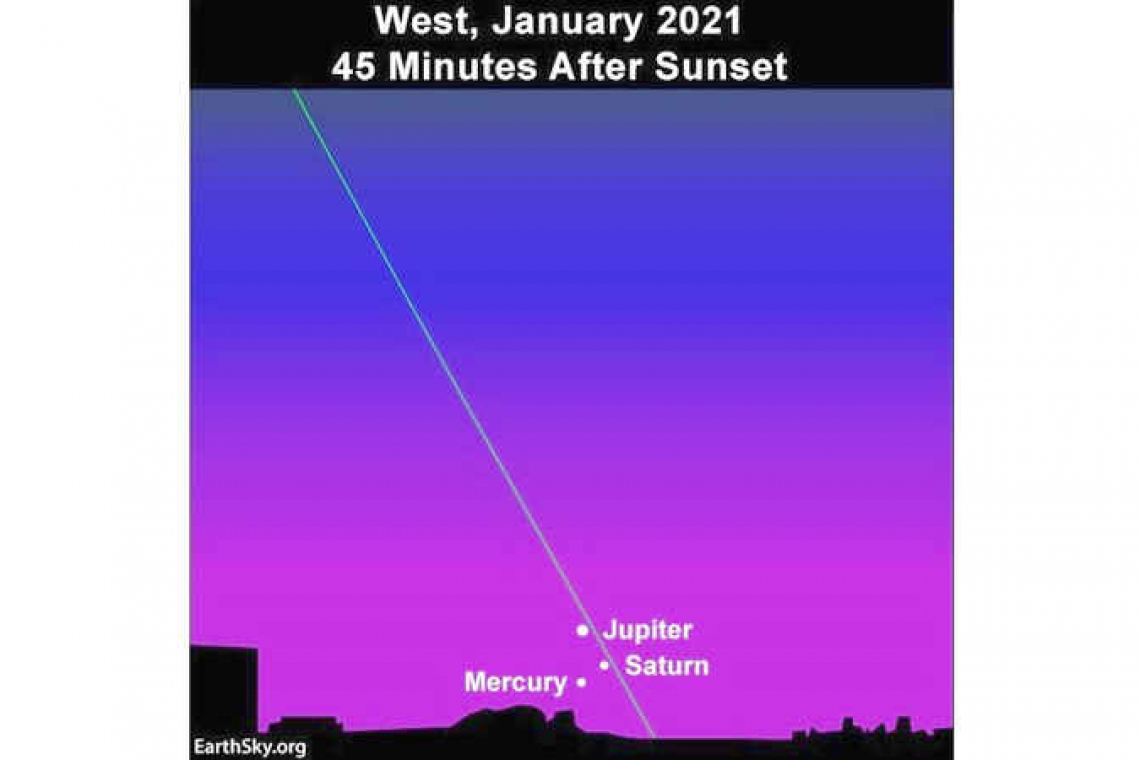~ St. Maarten’s Backyard Astronomy for January 8-10 ~
Sun rises at 6:45am
Sun sets at 5:52pm
Lunar phase: 3rd quarter, waxing crescent
Moon rises at 2:01am, Saturday
Moon sets at 1:48pm
This weekend, we can celebrate the new year with the sight of three planets all bunched up together on the sky’s dome. At dusk on the evenings of January 8, 9, 10 and 11, watch for the planets Mercury, Jupiter and Saturn to pop out low in the sky, rather close to the sunset point on the horizon. Jupiter is the brightest of the bunch, followed by Mercury and then Saturn. The tightest grouping of these worlds will be on January 10, 2021. Then Mercury will swing to the south of Jupiter on July 11, 2021, as shown on the chart.
To maximize your chances of seeing this celestial trio, find an unobstructed horizon in the direction of sunset. Start your search no later than 45 minutes after sundown. Although all these worlds are bright – especially Jupiter – they’ll be contending with the afterglow of sunset. You might need binoculars to catch one or two of these planets, especially Saturn.
By definition, a planetary trio consists of three planets fitting within a circle whose diameter is less than 5 degrees in width. (For reference, three fingers held together at arm’s length approximates 5 degrees.) Given that a typical binocular field of view spans at least 5 degrees, binoculars come in super handy for viewing a planetary trio. If you spot Jupiter with the naked eye alone, but not Mercury or Saturn, aim binoculars at Jupiter to see the threesome taking stage in a single binocular field!
Throughout the coming weeks, you may catch a glimpse of the elusive constellation Monoceros, the Unicorn. It’s well placed for viewing in the January evening sky, but you’ll need a very dark sky to see it. Monoceros will be out nearly all night long. It’ll be higher up and easier to see in the later evening hours.
To find the Unicorn, focus in on the Winter Triangle: three bright stars, Betelgeuse, Sirius and Procyon (see charts on this page). Within this triangle of stars, almost imperceptible among the many bright stars and constellations glittering brilliantly at this time of year – there’s a constellation that’s almost as hard to spot as its namesake is in countless fairy tales. Once again, you will need a very dark sky to see the constellation Monoceros, the Unicorn, but what better way to welcome the new year than with a view of stars twinkling down on us from their distant perch? The constancy of the heavens has comforted human beings through the millennia, and the infinite universe remains there for us through the challenges we face in 2021. Continue to thrive and stay safe!
Thank you for keeping up with the Night Sky articles designed for St. Maarten viewing. If you are out later on in the week, each star rises about four minutes earlier each day than written here, and the moon rises 50 minutes later. Night Sky is researched and compiled by Lisa Davis-Burnett. Earthsky.org is a key resource for information and images. Questions or comments? Email This email address is being protected from spambots. You need JavaScript enabled to view it.







